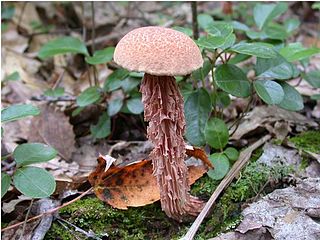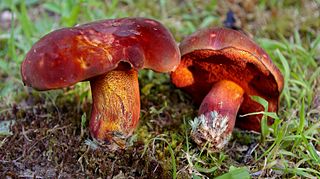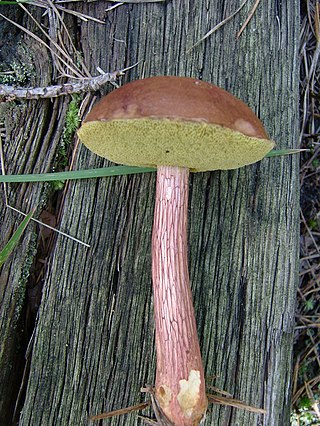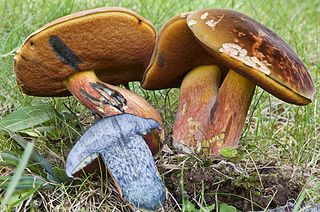
Rubroboletus pulcherrimus—known as Boletus pulcherrimus until 2015—is a species of mushroom in the family Boletaceae. It is a large bolete from Western North America with distinguishing features that include a netted surface on the stem, a red to brown cap and stem color, and red pores that stain blue upon injury. Until 2005 this was the only bolete that has been implicated in the death of someone consuming it; a couple developed gastrointestinal symptoms in 1994 after eating this fungus with the husband succumbing. Autopsy revealed infarction of the midgut.

Baorangia bicolor, also known as the two-colored bolete or red and yellow bolete after its two-tone coloring scheme of red and yellow, is an edible fungus in the genus Baorangia. It inhabits most of eastern North America, primarily east of the Rocky Mountains and in season during the summer and fall months but can be found across the globe in China and Nepal. Its fruit body, the mushroom, is classed as medium or large in size, which helps distinguish it from the many similar appearing species that have a smaller stature. A deep blue/indigo bruising of the pore surface and a less dramatic bruising coloration change in the stem over a period of several minutes are identifying characteristics that distinguish it from the similar poisonous species Boletus sensibilis. There are two variations of this species, variety borealis and variety subreticulatus, and several other similar species of fungi are not poisonous.

Suillellus luridus, commonly known as the lurid bolete, is a fungus of the family Boletaceae, found in calcareous broadleaved woodlands in Europe. Fruit bodies appear in summer and autumn and may be locally abundant. It is a firm bolete with an olive-brown cap up to 20 cm (8 in) in diameter, with small orange or red pores on the underside. The stout ochre stem reaches 8–14 cm (3–6 in) high and 1–3 cm (0.4–1.2 in) wide, and is patterned with a red network. Like several other red-pored boletes, it stains blue when bruised or cut.

Bothia is a fungal genus in the family Boletaceae. A monotypic genus, it contains the single species Bothia castanella, a bolete mushroom first described scientifically in 1900 from collections made in New Jersey. Found in the eastern United States, Costa Rica, China, and Taiwan, it grows in a mycorrhizal association with oak trees. Its fruit body is chestnut brown, the cap is smooth and dry, and the underside of the cap has radially elongated tubes. The spore deposit is yellow-brown. The edibility of the mushroom is unknown. Historically, its unique combination of morphological features resulted in the transfer of B. castanella to six different Boletaceae genera. Molecular phylogenetic analysis, published in 2007, demonstrated that the species was genetically unique enough to warrant placement in its own genus.

Exsudoporus frostii, commonly known as Frost's bolete or the apple bolete, is a bolete fungus first described scientifically in 1874. A member of the family Boletaceae, the mushrooms produced by the fungus have tubes and pores instead of gills on the underside of their caps. Exsudoporus frostii is distributed in the eastern United States from Maine to Georgia, and in the southwest from Arizona extending south to Mexico and Costa Rica. A mycorrhizal species, its fruit bodies are typically found growing near hardwood trees, especially oak.

Butyriboletus appendiculatus is an edible pored mushroom that grows under oaks and other broad leaved trees such as beech. It is commonly known as the butter bolete. It often grows in large colonies beneath the oak trees, and is frequently found cohabiting with old oaks in ancient woodland. It is relatively rare in Britain. Its stipe and pores are often bright yellow and its flesh stains bright blue when cut or bruised.

Aureoboletus mirabilis, commonly known as the admirable bolete, the bragger's bolete, and the velvet top, is an edible species of fungus in the Boletaceae mushroom family. The fruit body has several characteristics with which it may be identified: a dark reddish-brown cap; yellow to greenish-yellow pores on the undersurface of the cap; and a reddish-brown stem with long narrow reticulations. Aureoboletus mirabilis is found in coniferous forests along the Pacific Coast of North America, and in Asia. Unusual for boletes, A. mirabilis sometimes appears to fruit on the wood or woody debris of Hemlock, suggesting a saprobic lifestyle. Despite occasional appearances to the contrary, Aureoboletus mirabilis is mycorrhizal, and forms close mutualistic associations with hemlock roots.

Xerocomellus zelleri, commonly known as Zeller's bolete, is an edible species of mushroom in the family Boletaceae. First described scientifically by American mycologist William Alphonso Murrill in 1912, the species has been juggled by various authors to several genera, including Boletus, Boletellus, and Xerocomus. Found solely in western North America from British Columbia south to Mexico, the fruit bodies are distinguished by their dark reddish brown to nearly black caps with uneven surfaces, the yellow pores on the underside of the caps, and the red-streaked yellow stems. The fungus grows in summer and autumn on the ground, often in Douglas fir forests or on their margins. The development of the fruit bodies is gymnocarpic, meaning that the hymenium appears and develops to maturity in an exposed state, not enclosed by any protective membrane.

Boletellus ananas, commonly known as the pineapple bolete, is a mushroom in the family Boletaceae, and the type species of the genus Boletellus. It is distributed in southeastern North America, northeastern South America, Asia, and New Zealand, where it grows scattered or in groups on the ground, often at the base of oak and pine trees. The fruit body is characterized by the reddish-pink scales on the cap that are often found hanging from the edge. The pore surface on the underside of the cap is made of irregular or angular pores up to 2 mm wide that bruise a blue color. It is yellow when young but ages to a deep olive-brown color. Microscopically, B. ananas is distinguished by large spores with cross striae on the ridges and spirally encrusted hyphae in the marginal appendiculae and flesh of the stem. Previously known as Boletus ananas and Boletus coccinea, the species was given its current name by William Alphonso Murrill in 1909. Two varieties of Boletellus ananas have been described. Although the mushroom may be considered edible, it is not recommended for consumption.

Butyriboletus regius, commonly known as the royal bolete or red-capped butter bolete, is a basidiomycete fungus of the genus Boletus found in China and Europe. B. regius has a pink cap, yellow flesh, and a reticulate pattern on the stem. Harry D. Thiers described a similar mushroom from California as B. regius, though it is not the same species. B. regius in Europe does not stain when exposed to air, or stains weakly, but the California species stains blue. Both European and California species are considered choice edibles.

Aureoboletus russellii, commonly known as Russell's bolete, is a species of bolete fungus in the family Boletaceae. An edible species, it is found in Asia and eastern North America, where it grows in a mycorrhizal association with oak, hemlock, and pine trees. Fruit bodies of the fungus are characterized by their coarsely shaggy stem. The yellow-brown to reddish-brown caps are initially velvety, but become cracked into patches with age.

Tylopilus tabacinus is a species of bolete fungus in the family Boletaceae. It is characterized by a tawny-brown cap measuring up to 17.5 cm (6.9 in) in diameter, and a reticulated stem up to 16.5 cm (6.5 in) long by 6 cm (2.4 in) thick. A characteristic microscopic feature is the distinctive crystalline substance encrusted on the hyphae in the surface of the cap. The species is known from the eastern United States from Florida north to Rhode Island, and west to Mississippi, and from eastern Mexico. It is a mycorrhizal species, and associates with oak and beech trees.

Tylopilus alboater, called the black velvet bolete, by some, is a bolete fungus in the family Boletaceae. The species is found in North America east of the Rocky Mountains, and in eastern Asia, including China, Japan, Taiwan, and Thailand. A mycorrhizal species, it grows solitarily, scattered, or in groups on the ground usually under deciduous trees, particularly oak, although it has been recorded from deciduous, coniferous, and mixed forests.

Boletus rubroflammeus is a species of bolete fungus in the family Boletaceae. First described from Michigan in 1971, it is found in the eastern United States and Mexico, where it grows in a mycorrhizal association with hardwood trees. The fruit bodies (mushrooms) of the fungus have caps that are deep red to purplish red, and dark red pores. The stem has coarse, dark red reticulations and a narrow yellow area at the top. All parts of the mushroom quickly stain blue when injured or cut. Lookalikes include Boletus flammans, a lighter-colored species that grows with conifers. Other similar species can be distinguished by differences in distribution, morphology, staining reaction, and microscopic characteristics. Boletus rubroflammeus mushrooms are poisonous, and can cause gastrointestinal distress if consumed.

Boletus curtisii is a species of fungus in the family Boletaceae. It produces small- to medium-sized fruit bodies (mushrooms) with a convex cap up to 9.5 cm (3.7 in) wide atop a slender stem that can reach a length of 12 cm (4.7 in). In young specimens, the cap and stem are bright golden yellow, although the color dulls to brownish when old. Both the stem and cap are slimy or sticky when young. On the underside of the cap are small circular to angular pores. The mushroom is edible, but not appealing. It is found in eastern and southern North America, where it grows in a mycorrhizal association with hardwood and conifer trees. Once classified as a species of Pulveroboletus, the yellow color of B. curtisii is a result of pigments chemically distinct from those responsible for the yellow coloring of Pulveroboletus.

Aureoboletus auriflammeus, commonly known as the flaming gold bolete, is a species of bolete fungus in the family Boletaceae. Described as new to science in 1872, it is found in eastern North America, where it grows in a mycorrhizal association with oaks. The caps of the fruit bodies are golden orange, with a yellow pore surface on the underside, and a reticulated (network-like) stem. The edibility of the mushroom is not known.

Boletus miniato-olivaceus is a species of bolete fungus in the family Boletaceae. Described as new to science in 1874, it is found in eastern North America and northeast Mexico.

Aureoboletus projectellus is a species of bolete fungus in the family Boletaceae. Found in North America, and recently in Europe, it grows in a mycorrhizal association with pine trees.

Boletus subvelutipes, commonly known as the red-mouth bolete, is a bolete fungus in the family Boletaceae. It is found in Asia and North America, where it fruits on the ground in a mycorrhizal association with both deciduous and coniferous trees. Its fruit bodies (mushrooms) have a brown to reddish-brown cap, bright yellow cap flesh, and a stem covered by furfuraceous to punctate ornamentation and dark red hairs at the base. Its flesh instantly stains blue when cut, but slowly fades to white. The fruit bodies are poisonous, and produce symptoms of gastrointestinal distress if consumed.

Tylopilus rhoadsiae, commonly known as the pale bitter bolete, is a bolete fungus in the family Boletaceae native to the eastern United States.























